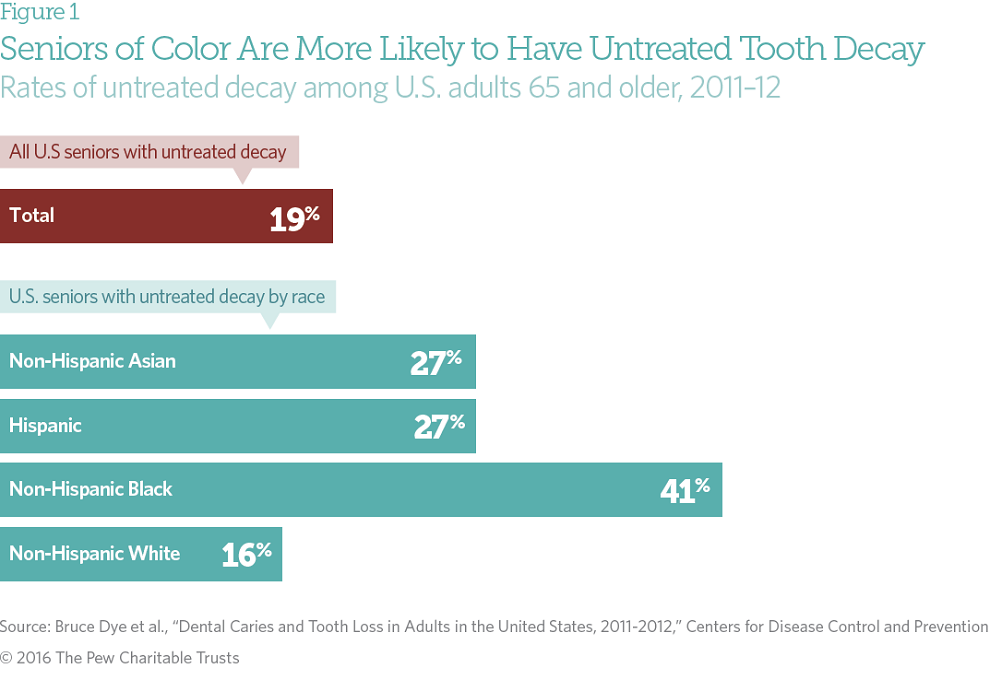Older Americans Need Better Access to Dental Care
Aging population means problem becoming more acute
 © Shannon Fagan/ Getty Images
© Shannon Fagan/ Getty ImagesOverview
U.S. seniors are keeping their teeth longer than they did in the past,1 yet many are unable to access preventive dental care or treatment to keep their mouths healthy.2 Senior citizens—those 65 and older—made up 15 percent of the U.S. population in 2014, and their share of the population is expected to nearly double by 2060.3 As the number of older Americans increases in the coming decades, the demand for care for this age group will intensify.
Low-income and black seniors are least likely to have access to dental care
- Almost 40 percent of seniors did not visit a dentist in 2014.4
- 35 percent of seniors living in poverty in 2014 had one dental visit, compared with 82 percent of seniors with incomes of roughly $45,000 or above.5
- 65 percent of white, 51 percent of Hispanic, and 43 percent of African American seniors had at least one dental visit in 2014.6
- Two-thirds of seniors with annual incomes below $35,000 in 2013 reported they could not afford care such as crowns, implants, or bridges.7
What health risks do seniors face from poor dental health?
Dental health care is especially important to older Americans because they are more likely to suffer from gum disease, which is associated with other significant health problems.
- More than 60 percent of seniors had moderate or severe gum disease in 2009-10, making them more susceptible to tooth loss and root decay.8 Low-income and African American seniors are about twice as likely as their more affluent and white peers to have gum disease.9
- Gum disease is associated with adverse outcomes from life-threatening conditions such as diabetes and heart disease.10
- About 1 in 5 adults 65 and older had untreated tooth decay in 2011-12; untreated decay rates among blacks are more than twice those of whites.11
- Seniors are seven times more likely to be diagnosed with oral cancer than are people younger than 65.12 Regular dental visits help to detect and treat oral cancer earlier.
- About 15 percent of 65- to 74-year-olds reported avoiding particular foods because of dental problems, opting for foods that are easier to chew, such as those high in saturated fats and cholesterol, rather than vitamin- and fiber-rich foods.13 As a result, tooth loss among older people is simultaneously associated with weight loss and obesity.14
- 37 percent of seniors living in poverty had no teeth in 2012 compared with 16 percent with incomes at or above twice the federal poverty line.15

What barriers do seniors face in accessing dental care?
The use of dental services declines as people age due to a variety of factors. Perhaps the single greatest barrier is the inability to afford care. Seniors with dental insurance are 2.5 times more likely than those without coverage to visit a dentist, and about half of seniors lacked insurance in 2015.16 Medicare, which provides health coverage for most U.S. seniors, does not pay for the routine, preventive, and restorative dental care seniors need.
Even among seniors with insurance, coverage does not necessarily translate into care. Medicaid covered 9 percent of all U.S. seniors (nearly 6.5 million) in 2011, and 49 percent of Medicare beneficiaries in assisted living facilities in 2010.17 However, the limited number of dentists who accept public insurance can make it difficult for seniors to find care. Between 1990 and 2013, the number of dentists who reported treating any patients on public assistance fell from 44 to 35 percent.18
Endnotes
- Bruce Dye et al., “Dental Caries and Tooth Loss in Adults in the United States, 2011-2012,” Centers for Disease Control and Prevention (May 2015), http://www.cdc.gov/nchs/data/databriefs/db197.pdf; and James E. Kelly and Claire R. Harvey, Basic Data on Dental Examination Findings of Persons 1–74 Years: United States, 1971-1974, Department of Health, Education, and Welfare (May 1979), http://www.cdc.gov/nchs/data/series/sr_11/sr11_214acc.pdf.
- Theresa Montini et al., “Barriers to Dental Services for Older Adults,” American Journal of Health Behavior 38, no. 5 (September 2014): 781–8, http://dx.doi.org/10.5993/AJHB.38.5.15.
- Sandra L. Colby and Jennifer M. Ortman, “Projections of the Size and Composition of the U.S. Population: 2014 to 2060,” U.S. Census Bureau (March 2015), https://www.census.gov/content/dam/Census/library/publications/2015/demo/p25-1143.pdf. In 2014 the U.S. was home to 46 million senior citizens, a group that is expected to reach 98 million by 2060.
- Centers for Disease Control and Prevention, “Health, United States, 2015: With Special Feature on Racial and Ethnic Health Disparities,” Table 78 (May 2016), http://www.cdc.gov/nchs/data/hus/hus15.pdf.
- Ibid.; and U.S. Census Bureau, “Poverty Thresholds” (2013), https://www.census.gov/data/tables/time-series/demo/income-poverty/historical-poverty-thresholds.html.
- Centers for Disease Control and Prevention, “Health, United States, 2015.”
- Oral Health America, “A State of Decay: Are Older Americans Coming of Age Without Oral Healthcare?—Vol. II” (2013), https://teethwisdom.org/a-state-of-tooth-decay-reports/.
- Paul I. Eke et al., “Prevalence of Periodontitis in Adults in the United States: 2009 and 2010,” Journal of Dental Research 91 (2012): 914–920, http://jdr.sagepub.com/content/91/10/914.
- Oral Health America, “A State of Decay.”
- Marjorie K. Jeffcoat et al., “Impact of Periodontal Therapy on General Health,” American Journal of Preventive Medicine 47, no. 2 (August 2014): 166–74, http://www.sciencedirect.com/science/article/pii/S0749379714001536.
- Dye et al., “Dental Caries and Tooth Loss.”
- Clemencia M. Vargas , Ellen A. Kramarow, and Janet A. Yellowitz, “The Oral Health of Older Americans,” Centers for Disease Control and Prevention (March 2001), https://www.cdc.gov/nchs/data/ahcd/agingtrends/03oral.pdf.
- Susan O. Griffin et al., “Burden of Oral Disease Among Older Adults and Implications for Public Health Priorities,” American Journal of Public Health 102, no. 3 (March 2012): 411–18, http://www.ncbi.nlm.nih.gov/pmc/articles/PMC3487659/.
- Ibid.
- Medicaid and CHIP Payment and Access Commission, “Medicaid Coverage of Dental Benefits for Adults,” in Report to Congress on Medicaid and CHIP” (June 2015), https://www.macpac.gov/wp-content/uploads/2015/06/Medicaid-Coverage-of-Dental-Benefits-for-Adults.pdf.
- Oral Health America, “A State of Decay”; and Jerry Berggren, director of research and information, National Association of Dental Plans, pers. comm. with Jane Koppelman, The Pew Charitable Trusts, April 29, 2016.
- Henry Kaiser Family Foundation, “State Health Facts: Medicaid Enrollment by Age, FY2011,” http://kff.org/medicaid/state-indicator/medicaid-enrollment-by-age; and U.S. Department of Health and Human Services, “A Profile of Older Americans: 2013,” http://www.aoa.gov/aging_statistics/Profile/2013/docs/2013_Profile.pdf.
- American Dental Association, “Characteristics of Private Dental Practices: Selected 2013 Results From the Survey of Dental Practice” (Excel) (February 2015), http://www.ada.org/~/media/ADA/Science%20and%20Research/HPI/Files/HPIData_SDPC_2013.ashx.








